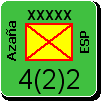Bessarabia has been claimed by USSR and the claim rejected. So there is a war.
GE has sent some "peacekeepers" to the border and they have been attacked by USSR forces.
Both players agree that the GE land units can be attacked because they are in a RO controlled hex, even if they are not at war.
They disagree in the GSupport phase, when a GE bomber is intercepted by a URSS fighter.
One says that it can be done because they are fighting over and GE is supporting the hex attacked, the other says the air combat is handled differently because GE and URSS planes would not fight because the rule does not cover the air dogfight over the contested hex.
He agrees they both could bomb the hex but he says no dogfighting is allowed.
Here is the most relevant ruling, IMO:
9.9 Multiple states of war
Because you can be at war with some
major powers but not others, you will encounter cases where you are opposed by some units at war with you and by others that aren’t. This rule deals with those cases.
A unit may not enter or attack a hex (or units therein) controlled by a major power on the other side that it isn't at war with. However it can attack a hex controlled by an enemy major power or minor country even if the hex contains units it is not at war with.
In attacking such a hex, you must fight all units there, but both sides ignore the fact that you may not be at war with all of them. This means that each side could fly air missions to the hex and use shore bombardment etc. as if they were all at war.
You can only support an attack against units you control if the supporting units are the same nationality as the unit (or hex during strategic bombardment) being attacked or at war with at least one major power or minor country attacking those units (or hexes).









